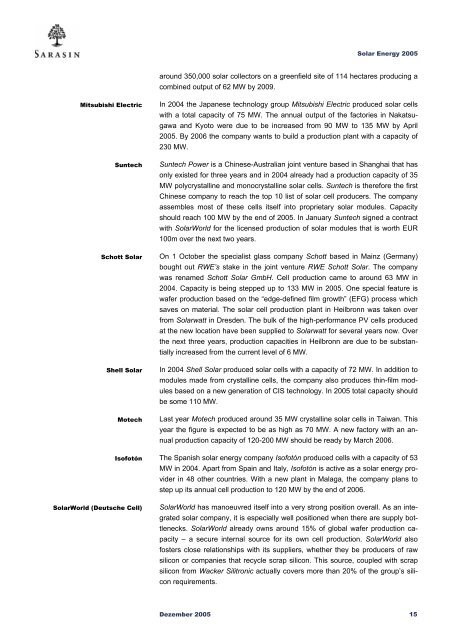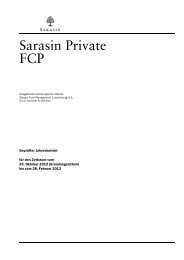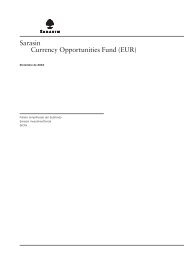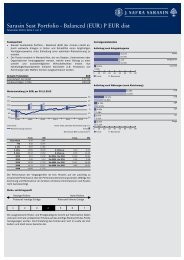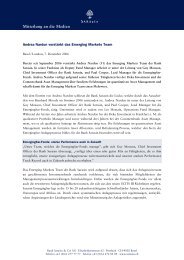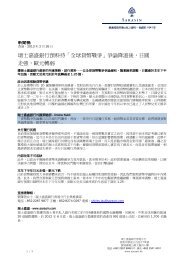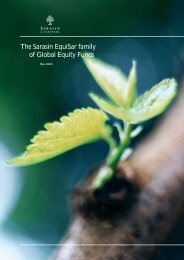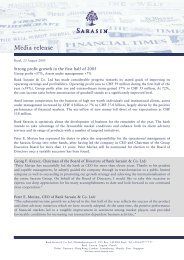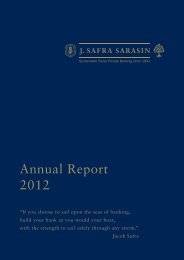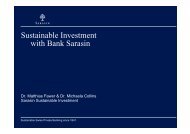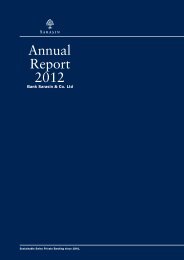Sustainability Report - Bank Sarasin-Alpen
Sustainability Report - Bank Sarasin-Alpen
Sustainability Report - Bank Sarasin-Alpen
Create successful ePaper yourself
Turn your PDF publications into a flip-book with our unique Google optimized e-Paper software.
Solar Energy 2005<br />
around 350,000 solar collectors on a greenfield site of 114 hectares producing a<br />
combined output of 62 MW by 2009.<br />
Mitsubishi Electric<br />
Suntech<br />
Schott Solar<br />
Shell Solar<br />
Motech<br />
Isofotón<br />
SolarWorld (Deutsche Cell)<br />
In 2004 the Japanese technology group Mitsubishi Electric produced solar cells<br />
with a total capacity of 75 MW. The annual output of the factories in Nakatsugawa<br />
and Kyoto were due to be increased from 90 MW to 135 MW by April<br />
2005. By 2006 the company wants to build a production plant with a capacity of<br />
230 MW.<br />
Suntech Power is a Chinese-Australian joint venture based in Shanghai that has<br />
only existed for three years and in 2004 already had a production capacity of 35<br />
MW polycrystalline and monocrystalline solar cells. Suntech is therefore the first<br />
Chinese company to reach the top 10 list of solar cell producers. The company<br />
assembles most of these cells itself into proprietary solar modules. Capacity<br />
should reach 100 MW by the end of 2005. In January Suntech signed a contract<br />
with SolarWorld for the licensed production of solar modules that is worth EUR<br />
100m over the next two years.<br />
On 1 October the specialist glass company Schott based in Mainz (Germany)<br />
bought out RWE’s stake in the joint venture RWE Schott Solar. The company<br />
was renamed Schott Solar GmbH. Cell production came to around 63 MW in<br />
2004. Capacity is being stepped up to 133 MW in 2005. One special feature is<br />
wafer production based on the “edge-defined film growth” (EFG) process which<br />
saves on material. The solar cell production plant in Heilbronn was taken over<br />
from Solarwatt in Dresden. The bulk of the high-performance PV cells produced<br />
at the new location have been supplied to Solarwatt for several years now. Over<br />
the next three years, production capacities in Heilbronn are due to be substantially<br />
increased from the current level of 6 MW.<br />
In 2004 Shell Solar produced solar cells with a capacity of 72 MW. In addition to<br />
modules made from crystalline cells, the company also produces thin-film modules<br />
based on a new generation of CIS technology. In 2005 total capacity should<br />
be some 110 MW.<br />
Last year Motech produced around 35 MW crystalline solar cells in Taiwan. This<br />
year the figure is expected to be as high as 70 MW. A new factory with an annual<br />
production capacity of 120-200 MW should be ready by March 2006.<br />
The Spanish solar energy company Isofotón produced cells with a capacity of 53<br />
MW in 2004. Apart from Spain and Italy, Isofotón is active as a solar energy provider<br />
in 48 other countries. With a new plant in Malaga, the company plans to<br />
step up its annual cell production to 120 MW by the end of 2006.<br />
SolarWorld has manoeuvred itself into a very strong position overall. As an integrated<br />
solar company, it is especially well positioned when there are supply bottlenecks.<br />
SolarWorld already owns around 15% of global wafer production capacity<br />
– a secure internal source for its own cell production. SolarWorld also<br />
fosters close relationships with its suppliers, whether they be producers of raw<br />
silicon or companies that recycle scrap silicon. This source, coupled with scrap<br />
silicon from Wacker Silitronic actually covers more than 20% of the group’s silicon<br />
requirements.<br />
Dezember 2005 15


